
Ventilation
Heat and moisture are your enemies when it comes to your home. But just because you can’t see them doesn’t mean they aren’t there… hiding in your attic and causing damage. Solar Star Attic Fans neutralize moisture and drive out heat, keeping your home cool in summer and protecting it from harm during the winter.
Summer
Summer means longer days, more sun, and warmer temperatures. If heat isn’t vented from your attic properly, it builds up and causes problems in your home:
- Living spaces become hot and uncomfortable
- Air conditioning units work harder to keep rooms cool
- Utility costs rise due to increased energy demand
- Roof structures and materials deteriorate
A Solar Star Attic Fan solves these problems by removing excess heat from your home, giving you a more comfortable interior and lower energy bills.
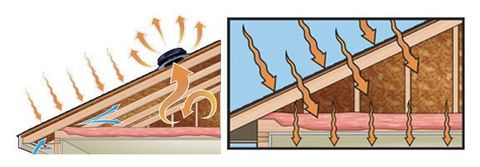
Product Selection Guide
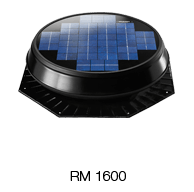
RM 1600
The RM 1600 Attic Fan generates maximum power to battle built-up heat and moisture in your attic. It’s the ideal solar-powered ventilation solution for large attic spaces and extreme climates.
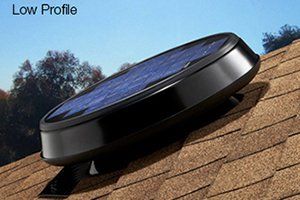
Low Profile Roof Mount
This sleek, unobtrusive design is for most pitched roof application. Meets Florida Building Code (FL10884) and Texas Department of Insurance (RV-57).
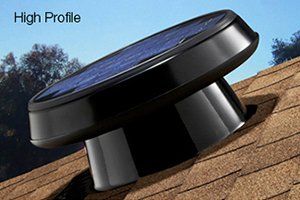
High Profile Roof Mount
This aerodynamic design is perfect for locations with heavy snow loads. Meets Florida Building Code (FL10884) and HVHZ (FL14826), as well as Texas Department of Insurance (RV-57).
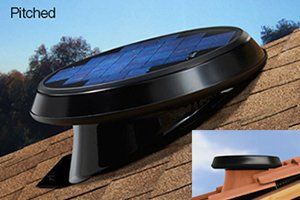
Pitched Roof Mount
A great alternative for pitched roofs when you need to improve exposure to the sun.
Tax credits for Solar Star Attic Fans
Which models qualify for tax credits?
All Solar Star Attic Fans are considered residential photovoltaic systems, which means they turn sunlight into energy, so a portion of the cost of the fans qualify for a 30% federal income tax credit.
In IRS Notice 2013-70, a clarification was made that specifically excludes portions of Solar Powered Exhaust Fans. Solar Star is a hybrid product that is both an exhaust fan and produces electricity. The electricity producing portion of the product is eligible for the 30% federal tax credit while the fan portion is not eligible.
The electricity producing solar panel and related components of the Solar Star are 70% of the overall cost of the unit. Therefore, both the unit and installation are credit eligible at 70% of the total Solar Star sales price to the customer.
What is the Emergency Stabilization Act of 2009?
On Oct. 3, 2008, George W. Bush signed the Emergency Stabilization Act of 2009, which extended the credits available for solar-powered energy systems and expanded the qualifying product requirements. This allows for a 30% tax credit on the purchase and installation of residential solar water heating, photovoltaic (solar electric) equipment, and fuel cell property.
What do I need in order to claim the tax credit?
You’ll need your receipt for purchase and installation, a Manufacturer’s certification (see above), and IRS Form 5695.
Is there a cap on the tax credit?
There is no credit cap for residential photovoltaic systems placed into service after December 31, 2008.
Do Solar Star products in my second home or rental property qualify?
Existing homes and new construction qualify; as well as primary residences and secondary residences, such as vacation homes. Rental properties do not qualify.
Are the Solar Star DIY kits eligible?
Yes, Solar Star Attic Fan DIY Kits – both roof and interior mount kits – are eligible. Of the total product price, 70% qualifies for the tax credit.
Are Solar Star products eligible even though they aren’t ENERGY STAR® rated?
An ENERGY STAR rating is not required for the photovoltaic system tax credit eligibility program.
General tax credit information
What is the difference between a tax deduction and a tax credit?
A tax deduction is subtracted from income before total tax liability is computed. On the other hand, a tax credit is subtracted directly from the total tax due or added to the expected tax refund. For example, if your paid $665 for a Solatube 160 ISn with installation, you would earn a $200, or 30%, tax credit, which you would add to your federal tax refund or subtract from the amount you owe.
When were the tax credits established and when do they expire?
Tax credits for residential solar installations were initially created under the Energy Policy Act of 2005, and have been extended several times under other additional acts. In 2015, the credits were extended once again. The 30% tax credit for residential installations extends until the end 2019, and then begins a step down until 2023, after which it will phase out completely.
What do I need in order to claim the tax credit?
You’ll need your receipt for purchase and installation, a Manufacturer’s certification (see above), and IRS Form 5695.
Are there local incentives for my county and/or city?
Many local utilities provide financial incentives for energy-efficient products. To find out if rebates or incentives are available in your area, visit the ENERGY STAR rebate finder at www.energystar.gov. For additional information, please visit your state energy office website for specific state tax information or go to http://www.dsireusa.org/ to view the database of State Incentives for Renewables and Efficiency.
Does a product with an ENERGY STAR rating automatically qualify for federal tax credits?
Prior to December 31, 2013, all products with the ENERGY STAR label were eligible for 10 % federal tax credits because of their ability to operate efficiently and lower energy bills. After this date, there may be some ENERGY STAR rated products that do not qualify for federal tax credits. To find out for sure, it’s recommended you visit www.irs.gov or consult a tax professional for advice.
